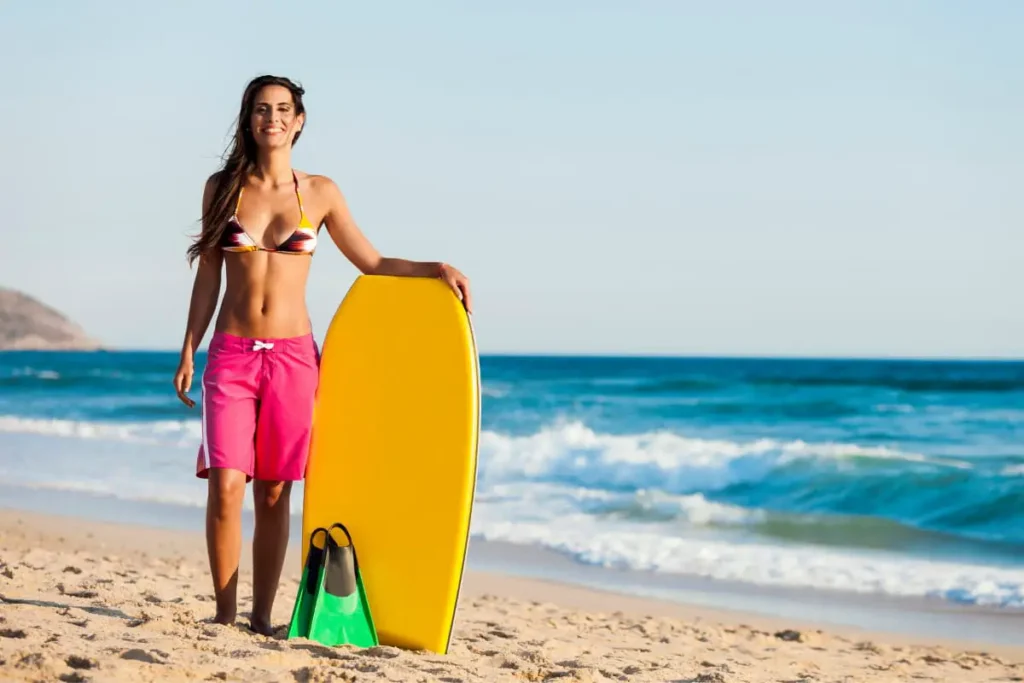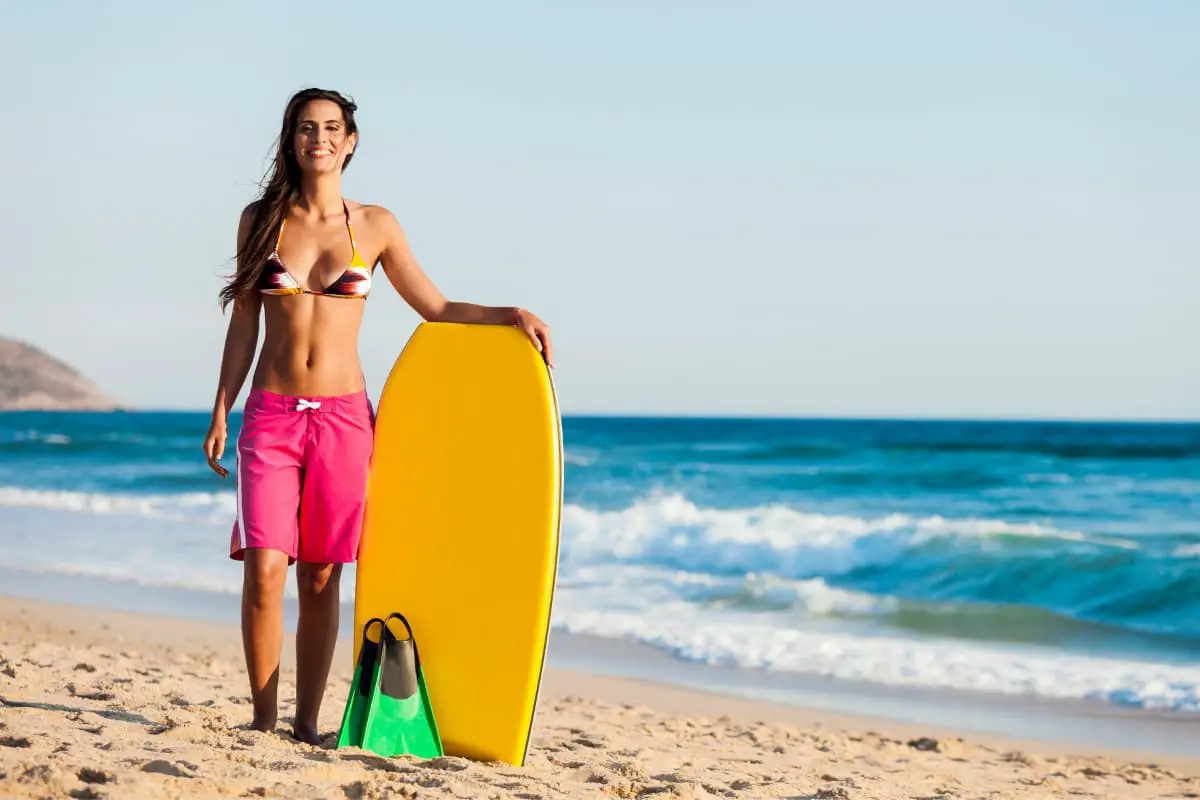Suppose you are enthusiastic about bodyboarding, or you are just new to this sport. In that case, you may have noticed many bodyboard options out there.
Here we will provide you with information that can help to find the right bodyboard for you.
To pick the right bodyboard, place the board standing on the floor; if it reaches your abdomen without going over your belly button, it is the right size for you.
Knowing your body’s measurements is essential. If you try to buy a bodyboard online or in a surf shop, you will see they come in different sizes to choose from.
Experienced bodyboarders will also choose a board based on their skills in the sport.

Understanding The Basics Of A Bodyboard
Before we begin talking about which bodyboard is the one that fits you, there are a few historical concepts you need to know.
The History Of Bodyboards
Bodyboarding has its origins in Hawaii long before the 20th century. Back then, people used to make wooden boards known as “papa li’ili’i” or “paipo,”which were the ancestors of today’s bodyboards.
A few years after Hawaii became part of the U.S., board surfing grew worldwide. Foreigners loved this sport because it was easier to practice when compared to surfing.
Tom Morey: Musician And Engineer
By the 1970s, the American musician Tom Morey designed a few modifications to the original paipo, which converted it into the bodyboards we know now.
Thus, people regard Tom as the father and inventor of the bodyboard.
Tom made the original design of the bodyboard in one night. He already had a 4-foot, round nose board, and a flat tail made out of polyethylene by the next day.
However, it was only a prototype, and Tom wanted to confirm if it would work.
As soon as he found out his new invention was working, Tom knew he created something big.
A few months after his creation, he partnered with Larry Gordon and Floyd Smith to create a commercial product.
Finally, people said “goodbye” to surfing boards and welcomed the new generation of small boards.
“The name of the product was “Morey Boards.” At the time, there was only one board model; buyers didn’t have many options to choose from.
However, the marketing campaign in surf publications made these boards famous.
Today’s Bodyboards
Nowadays, we have many brands and types of bodyboards. There’s a whole science behind these boards.
Bodyboard Components
The prototype was very simple, but today bodyboards include the following parts:
- Stringer is a removable stick that helps to give more rigidity to the board. Most options include one to two stingers.
- Different tail shapes, the most common are crescent and bat, in clipped and unclipped options. Other forms are gullwing, round, v, square, and m. The tail shape helps you to maintain stability when the board touches the wave.
- There are three new materials besides polyethylene; we have polypropylene, polystyrene, and extruded Polystyrene. The material affects the rigidity and weight of the board.
Bodyboard Structure
The bodyboard includes the following features:
- A nose is the upper part of the board. When you lay flat on the board, the nose will always go in front of you, leading the way.
- The deck is part of the board where you would lay your upper body.
- The slick is the bottom part that has direct contact with the wave.
- The rails are the edges you grab on each side of the board.
Bodyboard Size
Most bodyboards start at 36 inches and go up to 40 inches long. Also, other options can go up to 45 inches.
Choosing the right length is an easy task. We have created a size chart here that would guide you to find the perfect size for you.
| If your height is between | And your weight is inside | Your board size should be within |
| 4’10” or less | Less than 90 lbs | 34″ and 38″ |
| 4’8″ to 5’0″ | 65 and 100 lbs | 36″ and 39″ |
| 4’6″ to 5’2″ | 85 and 115 lbs | 38″ and 40″ |
| 5’3″ to 5’6″ | 110 and 140 lbs | 39″ and 41″ |
| 5’6″ to 5’8″ | 125 to 170 lbs | 40″ and 42″ |
| 5’7″ to 6’0″ | 145 and 180 lbs | 42″ and 43″ |
| 6’1″ to 6’3″ | 170 and 210 lbs | 43″ and 44″ |
| 6’2″ to 6’4″ | 180 and 250 lbs | 44″ and 45″ |
| 6’3″ to 6’6″ | 195 and 270 lbs | 45″ and 46″ |
| 6’4†or more | More than 220 lbs | 45″ and 48″ |
Bodyboards Types
There are some bodyboard types available for you to choose from. Each option has different characteristics; let’s see some of the most common.
Dropknee
This type of board is usually large. You can find 32″ options, but the average size is 42″. Also, you can find options as large as 55″.
Dropknees are great if you look for a table where you can go in a kneeled position.
Big boards
These boards are created for big people. They are the largest bodyboards available. The sizes start at 42″ and can go up to 55″ long.
Mini bodyboards
You can use them for kickboard and bodyboarding. The longest option will be around 22 inches.
Inflatable and tandem bodyboards
These options are easy to carry around and store. You can find tandem boards up to 50 inches long!
Skimboards
These tiny boards are small in size, which makes them perfect for adults and kids.
Other Bodyboard Options
- Rented bodyboards
Some shops will offer the option to rent a bodyboard. It is excellent if you want to try out a board before you decide to purchase.
Also, if you don’t plan on traveling with your bodyboard, you could rent one instead.
- Custom-made boards
You will choose all the features of your board. The shop will create a bodyboard with the core, height, weight, tail, and colors you choose.
- Single-use boards
These options are usually made of cheap materials. And sometimes end up broken.
Frequently Asked Questions
Is bodyboarding easier than surfing?
For most people, bodyboarding is easier to learn when compared to surfing because they don’t have to keep balanced standing up on the board.
Additionally, you can use your limbs to maintain control of your bodyboard.
Are all boogie boards the same?
Boogie board is the commercial name of the original bodyboard. Back then, boogie boards came in a standard model. Now, we have bodyboards that can adapt to your size, weight, and expertise in the sport.
What is the best core for a bodyboard?
Experts say the best core is polypropylene. It weighs less than polyethylene while offering foam memory missing in extruded polystyrene.
How do you stand up a bodyboard?
To stand up on a bodyboard, you must consider using a longboard to keep you balanced. Once you find a wave to ride, grab the rails, do a push-up to separate your chest from the board, and move your feet to the deck of your board.
Is skimboarding easier than surfing?
Yes, it is because you don’t need to ride waves to skimboard.
Is bodyboarding a good workout?
Yes, it is. To move around, you will kick with your legs and also will use your arms to steer.
Some of the muscles used in these movements include glutes, quadriceps, hamstrings, deltoids, and trapezius. Additionally, your core muscles are engaged all the time.
Do you need wax for a bodyboard?
Not really. When you go bodyboarding, wear rash guards or a wetsuit, and there is no need for you to wax.
Conclusion
Picking the right board seems like a lot of work. But it doesn’t have to be. If you want to make it a simple decision, go for the size.
In the end, if you are looking to enjoy the experience and don’t know which size to choose, you can use our size chart to help you find your fit.
Once you acquire more experience, you can choose different tails, materials, and sizes to improve your rides.

